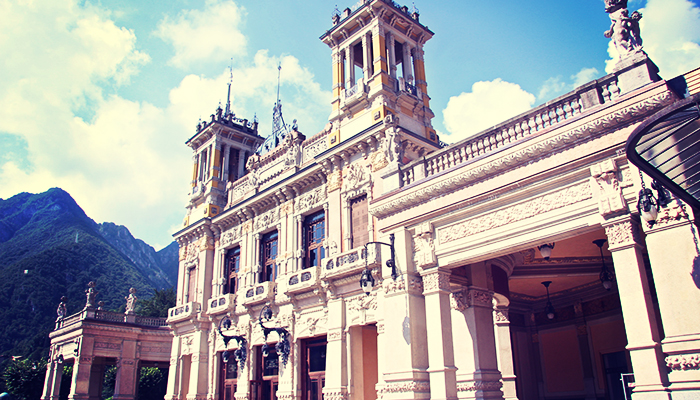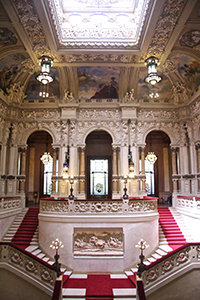
While there’s really no bad time to visit Italy, September marks the start of the Tuscan vendemmia, or grape harvest, when warm days ease into cooler nights and the countryside starts to glow with the golden hues of autumn. Each little hillside hamlet seems to come to life with its own wine-infused sagra, or festival, celebrating ravioli, truffles, chestnuts and more. Many travelers flock to the area in hopes of helping with the harvest, but find they must be registered with an official work experience program to be properly contracted and insured for what is often a rigorous full day of work. If you’re planning a trip to northern Italy this fall, consider opting instead for one of these unique culinary destinations.
Get Pampered at a Tuscan Olive Oil Resort
Villa Campestri, located about 20 miles from Florence, is an olive oil resort set in a stunning Renaissance villa surrounded by ancient olive groves. Stay in classic Florentine-style suites and apartments featuring antique furniture, period ceramics and an expansive view of the Mugello valley. Owner Paolo Pasquali leads olive oil tastings in the cellar, where you will learn about the history of the olives, then smell and taste the various characteristics of different oils. The session ends with a tour of the oil press and the grove, where the organic olives are hand harvested and processed the same day.
The perfect follow-up to an olive oil tasting is a meal at L’Olivaia, where chef Andrea Perini showcases the oil with exquisite dishes such as caprino pear mezzelune served over walnut sauce and Cinta Senese medallions coated in chestnut-honey sauce and nestled in celeriac puree — all drizzled generously with the fresh extra virgin olive oil. You can also register for chef-led cooking classes, ranging from a single lesson on how to craft easy dishes with olive oil, to more specialized multi-day courses on making homemade pasta, Tuscan sauces, breads and pizzas.
And that’s only the beginning. Take part in a beekeeping class before assisting in honey extraction and sampling three local varieties. Go truffling in the oak forests surrounding Via Campestri, where the scorzone black truffle can be harvested from June through November. Explore mountain biking trails of varying difficulty around the property, or purchase an olive tree to plant on the grounds. Join a class with an artist who specializes in 14th-century painting and drawing techniques, such as frescoes and egg tempera on gold leaf. Arrange for an olive oil massage in your room or under an ancient olive tree. Or simply relax in the serene pool surrounded by majestic cypress trees, overlooking the Tuscan hills.
Visit the Source of Some of the World’s Finest Mineral Water
While Italians are known for their generous consumption of some the best wine in the world, they take their water just as seriously. Each meal begins with the selection of mineral water — either acqua naturale (still water) or acqua frizzante (sparkling) — and both are enjoyed not only for their taste, aroma and mouthfeel, but also for the high saline content and presence of beneficial bicarbonates, sulfates and calcium. Just like wine, locally sourced mineral water is an expression of its terroir and intrinsic to the culinary experience.
Just this summer, in celebration of Acqua Panna’s 450th anniversary, Gianni Salvadori, Tuscany’s minister of agriculture, signed a historical agreement naming the water an official ambassador of Tuscany. The mineral-rich still water that’s sipped in more than 120 countries has been sourced and bottled at Villa Panna, once the holiday estate of the Medici family, since 1564. Its sparkling counterpart, San Pellegrino, is sourced in the foothills of the Italian Alps, in the town of San Pellegrino Terme. In the 1800s, celebrities and royals flocked to the area to bathe in the waters that had become known for their therapeutic effects. In 1899, the owner began bottling and distributing the coveted water, which remains a staple of Italian culture.
A visit to San Pellegrino Terme is worth the beautiful drive alone. The road winds through Val Brembana, where little towns are built into the lush Prealps. Stop for lunch at Bigio, the oldest restaurant in town, and sample hearty Lombard fare such as rustic polenta and savory pork stew — paired with Campari and San Pellegrino, of course. Book a tour at the crown jewel of the town, the breathtaking Casinò di San Pellegrino Terme, which opened its doors in 1907 during La Belle Époque. The gilded structure is the same building that’s illustrated on the sparkling water label. Aristocrats came from all over the world to socialize, gamble and receive spa treatments for ailments ranging from kidney stones to melancholy. QC Terme is about to add pages to San Pellegrino’s history by opening a new state-of-the-art spa this winter. Can’t wait that long? Visit QC Termemilano, in nearby Milan, which features biosaunas, hydotherapy, steam baths, and a salt room. Afterward, stay the night at Spadari al Duomo or Bvlgari Hotel Milan, two chic hotels where design is just as important as comfort.
See Italy’s Most Poetic Butcher in Chianti
You may go to Chianti for the wine, but you’ll find yourself staying for the beef — at least if you venture to Panzano to visit Dario Cecchini, hailed as the best butcher in Italy. The charismatic culinarian gained a following after author Bill Buford documented his work (and his ability to extensively quote Dante) in his book Heat. Gastronomes travel from all over Italy to buy cuts of beef, pork and lamb from his butcher shop, Antica Macelleria. Don’t expect to grab and go, though — Cecchini comes from eight generations of butchers and his enthusiasm is undeniable. (If you’re lucky, he’ll be sporting a full-body Italian flag ensemble.) You’ll be offered wine upon entering, then are welcome to browse cookbooks and look around the shop until Cecchini can give his undivided attention, explaining exactly how each cut can be cooked to perfection.
Come to Panzano on an empty stomach. In addition to the butcher shop, Cecchini owns three restaurants in the small town. Solociccia offers two communal seatings a night, featuring six courses of meat, vegetables, bread, wine, coffee and dessert. Dario Doc is Cecchini’s take on “fast food,” with items like a bunless burger served with potato wedges and housemade sauces, as well as butcher shop specialties such as Chianti sushi (beef tartare). Officina della Bistecca specializes in Florentine and Panzanese steak, with Tuscan beans and other sides for dipping in olive oil. In between meals, visit Accademia del Buon Gusto, where shop owner Stefano Salvadori is just as passionate about Chianti wine, which he samples out and pairs with chocolate and truffles.
There are plenty of villas and bed and breakfasts in and around the village, including several beautiful country houses owned by Marina Cecchini, Dario’s sister. Relais Fattoria Valle, once a holiday house for a noble Florentine family, looks out over the village and features a pristine pool and Tuscan cooking classes. If you’re heading back the 80 miles to Florence, book a room at Hotel Firenze Number Nine or Four Seasons Hotel Firenze. The former’s hammam is the perfect place to relax after a strenuous day of eating, while the latter’s amazing Il Palagio restaurant will tempt you for one last indulgent Italian meal.


